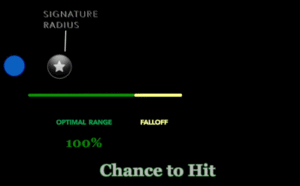More actions
colored text
- use colon to indent a line in a list
| Header text | Header text | Header text |
|---|---|---|
| Example | Example | Example |
---========================= In Brief
Fighting in space is a matter of physics. The detailed chart below is based on physics but doesn't show it. But some people want to see all the details, so the math in Turret Mechanics and Missile Mechanics does show it. You can find it there if you want it.
- If a target is standing still, you can hit it with anything. (The same is true of you … so keep moving.)
- Turrets fire a stream of stuff - pellets, pulses, ray beams - in a straight line.
- Missiles home in on their targets.
Signature radius sets the size of the target for the incoming weapons. Missiles explode when the get inside the target's radius. Turret streams hit when they get inside the radius.
Turrets fire a stream of stuff - pellets, pulses, ray beams - in a straight line.
- They miss a lot.
- But they fire fast, reload pretty fast and cost less.
- -Projectiles: use no capacitor, you can choose the damage type, cheapest ammo
- -Hybrid: use some capacitor, two damage types
- -Energy: use a lot of capacitor, two damage types, no reloading
Missiles home in on their targets.
- They hit more often.
- But they fire slowly, reload slowly and cost a lot.
For turrets, damage drops with range. Optimal range is the place where you have the best chance to hit - not guaranteed, just best odds. Falloff + Optimal = 50% chance to hit.

This is not a factor for missiles, but missiles have a maximum range, after which they never hit.
